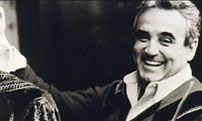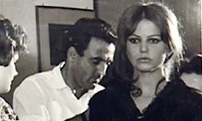
0% of page loaded...

Umberto Tirelli opened his atelier in November 1964 with two sewing machines, five seamstresses, a milliner, a secretary and a driver-warehouseman. Since then Tirelli has only grown.
History
Umberto Tirelli
Dino Trappetti
The great starring talk about Tirelli Costumi
Authentic Collection
Cinema Collection
Warehouse
Atelier

How can you explain the fact that Umberto Tirelli has not remained with his feet planted in the fields of Gualtieri, where he was born in 1928, and has chosen instead to dress Medea and Ludwig of Bavaria? Perhaps the existential curiosity of his family, perhaps fevers intellectual adolescence in the lower valley, perhaps the proximity to the snobbissima Parma, perhaps the only case in the likeness of a tailor his fellow countryman, Luigi Bigi, ambassador of French fashion. Bigi, which saw him working with glue and scissors, rummage in attics, recover old rags to create costumes and disguises, he said: "You have too much love for these things. You'll end tailor. "
His fate led him to dress not for men, but their representations, not the reality but the scene, not the present, but a history of crinoline and "quartered".
The first job is bellboy in a fabric shop in Milan. "Do not be in a hurry - the mother said - perhaps a free shop under the arcades and you can open a beautiful haberdashery." Years later, when Umberto arrived and will be happy in her beautiful costume workshop, mother Dirce continue to say: "Go there go there. Sares mei a nice stores in ca 'your'. In Milan, the offer of joining the Sartoria Finzi, costumes for the theater. Here is the first meeting with Luchino Visconti, already a legend for his penalty in the reconstructions of environments and clothes for him the characters were to be "alive, real, clothing, and not mannered." The tailoring done in 1955 by Visconti part of the customs of the historic Traviata, the one with the shoes of Violetta launched towards the proscenium to free your feet tired from dancing too.
That Tirelli for the director was an immediate crush artistic, a little farther on, it will become crucial in friendship in his life and in his work. That season in Milan was generous with intelligent and generous friendships: Franco Zeffirelli, who directed La Scala, Piero Tosi who created the costumes for the Sonnambula, Beppe Modenese she shared with him the two rooms, kitchen and bathroom.

Those of Safas are magic years: the television came from pioneering, the cinema had the sails to the wind, the opera was miraculously healed by the voices of Callas, Tebaldi, Di Stefano and Del Monaco. In prose triumphed in the head with the Society of Young Romolo Valli was born and the Spoleto Festival. For Tirelli are the years of meetings with the masters of talent and genius, but also able to understand, and to teach without ever fit in the chair. At the head of Luchino Visconti, who spent whole afternoons in the lab to Safas. For the Leopard from the beginning of 1962, the tailoring is monopolized for seven months and two thousand costumes: those of Fabrizio, Tancredi, Angelica, four toilets dance and all the partisans, the masses of the shepherds and peasants.
In 1964, two years after the faticatissimo set, Tirelli started his own business. A Tosca by Mauro Bolognini with costumes designed by Anna Anni is the first show signed by the "Sartoria Tirelli theatrical craft." Umberto Tirelli is something more and something less than a theatrical tailor, he understands that among the tailor with scissors, needle and thread, and the costume designer is an empty space to fill with professionalism. That is his job: creator of costumes and set fashion archaeologist. A definition that is more in line with his passion for the recovery period costumes and authentic accessories: buttons, buckles, ribbons, feathers, sashes, Dalmatian, trimmings, gloves, caps, handbags. Even in this Tosi Visconti and are the masters, dragging a Trovarobato that it becomes almost a disease: the pleasure to hunt between attics and trunks of fashion finds from resurrecting magically on stage.

Philologist of fashion, ally and shoulder costume for stage ideation, instinctive hound authentic and researcher of material impossible, to give life to all those "sketches" drawn on the scene sketches. For Medea Callas in 1969 uses rag grandmother's health and gauze, and boiled nettles and lemon peel to get some yellow and some green for the 1968 Rossini's Moses uses crochet sweaters, three-layer nylon for the capes, plastic casting molds and aged with burns to the armor. The association of work and friendship with the costume is essential. His "saints" are Piero Tosi and Pier Luigi Pizzi, one researcher documented, the other imaginative inventor.
In the early seventies Tirelli has no breath passes from Conformist by Bertolucci in Rome and Fellini's Amarcord, Tristan and Isolde on drawings Manzù, from Truffaut to Streheler, who entrusted him with his most beloved creature, the Cherry Orchard. These are the years for even more intensely cinematic Visconti, who, fresh out of the success of the Fall of the gods, ends up turning Death in Venice and is getting ready to monumental Ludwig, only to realize the mantle for the coronation scene tailoring it took three months. But with friends and they go in quick succession: die Visconti, Romolo Valli, Maria Callas, the mother dies Dirce, and Tirelli clings to work: Fellini, Cavani, Ronconi, Scola, Bolognini offer you a positive and happy defense against horrors of life.